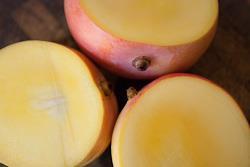
Asia’s consumers will see less Australian mangoes on retail shelves this season, with a hot winter and high rainfall colluding to reduce harvest by at least a quarter compared to last year, and an Australian dollar trading close to parity with the Greenback.
Winter in the Northern Territory this year, home to much of Australia’s mango production, was much warmer than average, according to growers. The state experienced some of its highest minimum winter temperatures ever recorded over May-July.
“It was astoundingly warm,” said Marie Piccone, managing director of grower Manbulloo Ltd, which trades outside Australia under its export arm Mango Road.
In Queensland, the country’s other major mango producing state, heavy rain during flowering and continuing into September has also caused problems. The wet weather has increased disease pressures, particularly from the fungus Anthrax Nose, which affects flowers and young fruit. The rain has centred on the Burdekin region.
“The crop is down on last year, without a doubt,” said Michael Simonetta, CEO of grower-marketer Perfection Fresh. “Overall, I’d say it’s down by 25 per cent at least.”
The mango season began in mid-September, and will continue through to around February.
Early pricing on the domestic market is looking good, according to Ms Piccone, and while the crop is down she told Fruitnet.com there would be enough to meet demand on the Australian market.
But while domestic demand is strong, the current high prices are probably not sustainable, said Mr Simonetta.
“The average Australian consumer is not going to keep paying A$4-5 a mango,” he told Fruitnet.com. “Most people have more pressing costs than mangoes.”
Export pricing is also expected to be high as a result of the short production and the high Australia dollar, which is trading at US$0.97.
Perfection Fresh, through its new export arm Sim-Ex, plans to target the Middle East the South East Asian markets this year, although Mr Simonetta said it’s unlikely any of those markets will see increased volumes.
Mango Road, meanwhile, is spending the season reworking its logistics setup, combining air and seafreight legs to cut costs and transit times, according to Piñata managing director Gavin Scurr, which also exports via Mango Road.
“We’re the only mango exporter that ships by sea out of Australia,” he explained. “We’re doing a sea and airfreight trial to Dubai, which is really innovative.”
The company is also sending three varieties of mango – Honey Gold, R2E2 and Kensington Pride – to Korea this year, the first Australian company to have done so since a protocol was signed for the market in 2006.



